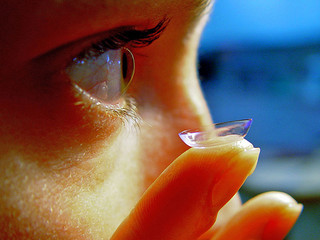Contact lenses are like sponges with tiny holes that permit entry of water and any other substance into the lens. With time, harmful materials may accumulate within the lens. These substances, which may include infectious agents, can penetrate the surface of the eye and cause irritation and infections, called corneal ulcers.
The surface cells of the cornea, on which the contact lens rest, are called epithelial cells. The action of the lids blinking wipes off the old cells so they can be replaced by new ones underneath. The life of these cells is around two months. During sleep, the normal blinking lid action is inhibited when wearing contact lenses. Therefore, these cells do not fall off at their normal time. These older cells become unhealthy and may lead to problems on the surface of the eye.
Contact lens makers have made them more permeable to oxygen and important nutrients, but they are far from perfect. Oxygen does not pass through as easily as it should, and waste products accumulate under the lens.
That is why, at Fort Lauderdale Eye Institute, we tend to fit daily wear, throw away contact lenses.
Some patients may be able to eliminate the need for contact lenses all together by seeing if they are a candidate for other permanent vision correction procedures.







